A description of the Wagyu beef cattle breed
Wagyu is a cattle breed which provides unrivalled dining excellence. There are four distinct Wagyu breeds - Black Wagyu (Japanese Black), Higo strain of Red Wagyu comprising 'Higo' strain (Akaushi/Japanese Brown which also include 'Tosa' strain in Japan), Wagyu Shorthorn (Japanese Shorthorn) and Polled Wagyu (Japanese Poll). They were selected and registered from the "Improved Japanese Cattle" in 1919.
Elite beef brand 'Sandai Wagyu' comprise Matsusaka, Kobe, etc. and is the benchmark for quality. These brands are only produced in Japan because there are regional and quality stipulations.
Distribution of Wagyu
There are two million fullblood (100% content) Wagyu globally. 96% are in Japan and the second highest population is in Australia. In Japan, beef is also produced from Wagyu over Holstein dairy females and F1 beef cross production in Japan is also the largest globally.
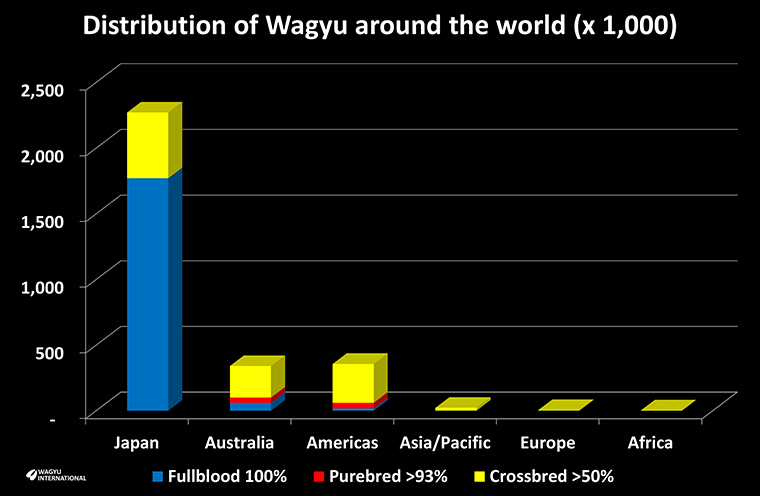
The USA has the highest population of Purebred Wagyu (15/16) which have been bred up crossing Wagyu with local breeds. Australia has the largest population of registered Fullbloods outside Japan and is annually registering about three times the number in USA.
Total Purebred Wagyu (>93.75% Wagyu content) constitute less than 3% of the total Wagyu population.
The highest number of crossbred Wagyu are in Japan and this is almost 50% of the total. The Americas, which include USA, Canada, Central and South America, comprise nearly 30% of all crossbreds. Australia.contains the next highest crossbred Wagyu population. With the proliferation of Wagyu crosses, the emphasis has swung over to quality and the proportion of F2 carcasses is increasing in the more competitive market of Australia.
Gains have been most significant in Europe over the past 10 years with several Wagyu associations being formed to assist develop the breed. More recently there has been strong growth in China and Wagyu have started to develope in Russia.
Total Wagyu, including crosses >50%, number 3 million head.
Japan
There is 1.8 million Wagyu, a half million Wagyu cross cattle and another half million dairy cattle which make up the source of beef in Japan. Traditional Wagyu breeding females exceed 500 000. Trends since 1960 are illustrated (MAFF, Minezawa 2003 and Namikawa 1992):
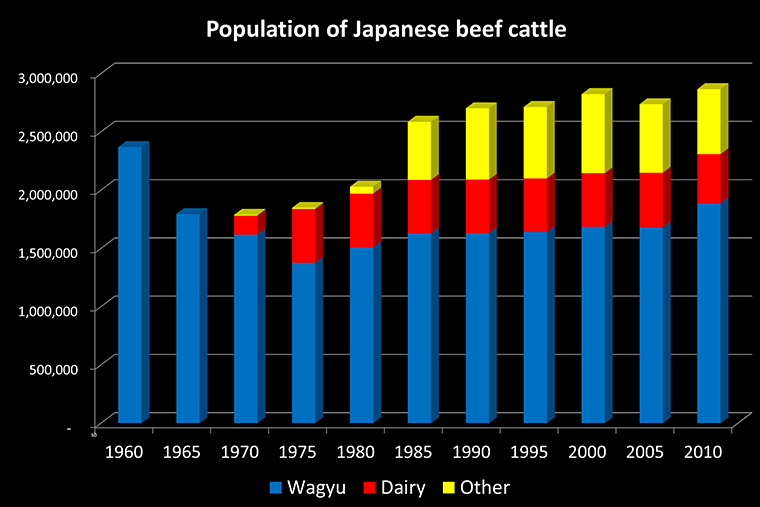
Australia
100 000 cattle are joined to Wagyu annually in Australia of which 18% are Fullblood and 12% are Purebred. 8% of births undergo full registration. Registrations of Wagyu by grade by year of birth from 1990 to 2010 are illustrated (data from Australian Wagyu Association):
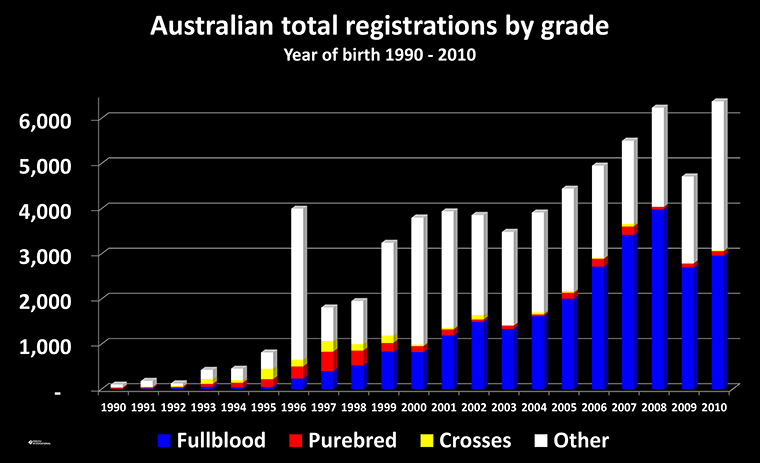
USA
The number of Wagyu registrations by grade by year of birth by the American Wagyu Association is illustrated (from American Wagyu Association). It was estimated in 2006 that there were 24,000 Wagyu-crosses on feed at any time out of 10 to 12 million cattle in total in USA feedlots. Registration information is available from the American Wagyu Association website.
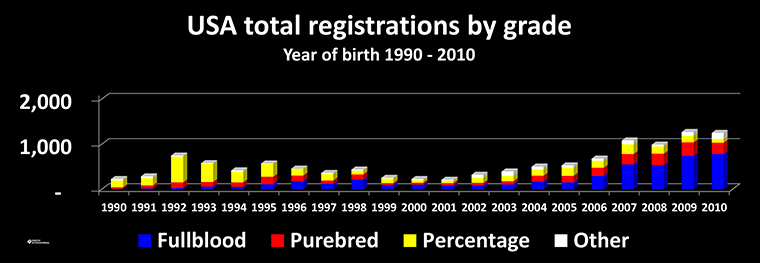
Global
Wagyu are produced on every continent. The Australian and American Wagyu Associations have members in the following countries:
Africa - South Africa
Americas - Brazil, Canada, Costa Rico, Mexico, Uruquay, USA
Asia/Pacific - Australia, China, Indonesia, Japan, New Zealand, Philippines and Vietnam
European Union - Denmark, England, Germany, Great Britain, Holland, Hungary, Ireland, Spain, Sweden
Wagyu breeds in Japan
There are four Wagyu beef breeds in Japan and population trends are illustrated below (Namikawa 1992 and MAFF):
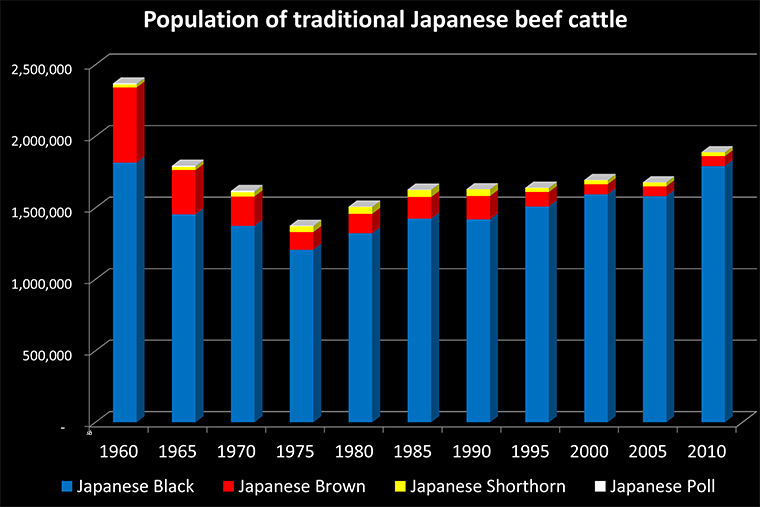
After trade liberalization in 1991 there has been growth in the numbers of Japanese Black despite the introduction of imported beef. The other Japanese beef breeds did decrease.
Japanese Black (黒毛和種 Kuroge washu) are found mainly in the Kansai and Chūgoku regions. Japanese Black constitute 94% of traditional Japanese beef breeds. They have a dull black coat and skin with a small to medium body size. The milk yield over 180 days is about 1 000 kg. Japanese Black produces the highest degree of marbling. This breed has horns but no humps.
Modern bloodlines can be traced back to the original Tsuru native cattle. They developed in separate but adjacent regions on the main Japanese island.
Takenotan-zuru were bred in 1830 in Atetsu and Okayama regions. They originated from one cow which produced 19 calves and a strong backline and loin with large size, fertility, and good udder were favoured. Okayama, Kedaka and Tottori are separate bloodlines tracing back to this strain.
Iwakura-zuru were selected for mild disposition, good looks, body conformation, good udder, longevity and fertility in 1843 in Hiba and Hiroshima. The Hiroshima bloodline is the end result.
A couple of years later in Hyogo and in the eastern part of Mikata the Shusuke-zuru developed. Bloodlines were selected for longevity, soundness and fertility and Tajiri lines oiginate here . They are generally smaller framed with slower growth rates so the cows are 50 kg lighter than the average and require an additional 2 to 4 months to grow out but they produce excellent meat quality with superior marbling.
In 1855 the Bokura-zuru were bred in Nita and Shimane. Similar characteristics to the Takenotan-zuru were selected so large-framed bloodlines evolved with good growth rate and gentle nature as similar criteria were used for selection as for the neighbouring Takenotan-zuru.
Measurements from progeny from sires from three regions are tabled (Smith et al., 2001):
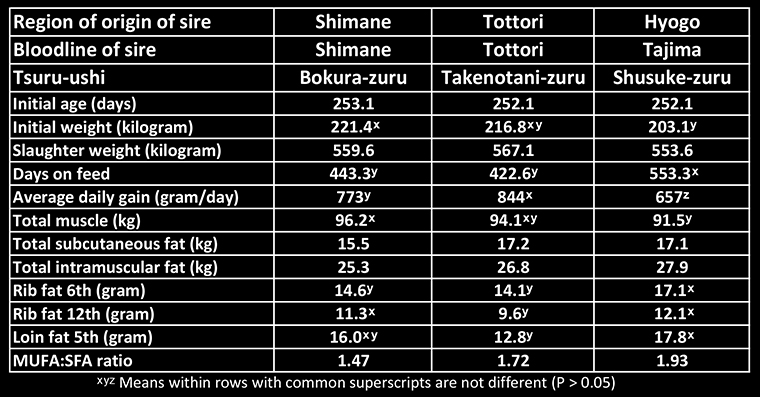
The national target set in 2000 for 2010 for Japanese Black steers was a slaughter age of 24-25 months, livemass of 670-685 kilogram from an average daily gain of 0.85 kilogram per day. A BMS (marble) score of 8.3 was set.
Japanese Brown (赤毛和種 Akage Washu or Akaushi) comprise two distinct strains. The use of different breeds during the Meiji Restoration was the major reason for those differences. Japanese Brown and Japanese Black cattle share the same recessive mutation Factor XI so this confirms that they were combined when that mutation occurred. This mutation is not present in Korean hanwoo so it originated in mainland Japan after the migration from Asia via the Korean peninsula.
The 'Higo' strain of Japanese Brown was developed in Kumamoto by crossing with Korean, Simmental and Devon. By 1922 the Higo strain had been established with a large frame and brown hair and the Simmental content was set at 25%. The predominant haplogroups are T4. This strain is more suited to range conditions and reaches large body size from high growth rate with a larger rib eye area. Lower marble score and feed efficiency was recorded in 140 days performance testing when compared with Japanese Black and Japanese Shorthorn. Mature cows are 600 kg and bulls 950 kg.
The 'Tosa' strain evolved during the Meiji Restoration in Kōchi prefecture on Shikoku Island. Simmental were crossed with Korean cattle introduced from Kyushu Island. The Kochi strain has a stronger Korean influence because Korean crossing was prolonged for longer than across the remainder of Japan. The predominant haplogroup is T3 as in Korean Hanwoo. They also have a yellow-brown coat, with a much lighter colour, than that of the Higo strain from Japan. The cattle with black skin at their horns, hooves, eyelids, muzzle, tongue, switch and anus fetched a higher value because they were typical of the original Korean breed. The beef quality is similar to Higo strain because of the Simmental contribution.
The Japanese Brown/Akaushi cattle that were selected for export from Japan through the USA are all Tosa strain from Kumamoto so no Higo strain Japanese Brown ever left Japan.
Japanese Brown exceeded one half a million head in 1960 and comprised 22% of the traditional beef herd. By 1990 the share had dropped to 9%, and presently comprises 4% of the traditional beef herd and well established as the second most prolific Wagyu beef breed. With a lower fat content, its tastiness and texture has been attracting a great deal of attention and the release of more flavour is promoted from chewiness.
Improvements of breeding followed from the introduction of ET in Kumamoto in 1984 and attention to meat quality began as selection had been primarily on size for a longer period than in the Japanese Black. The Simmental content has been retained in Akaushi for almost 100 years since the crossbreeding ceased and found to be 25% in Kumamoto through DNA satellite testing.
The national target set for 2010 for Japanese Brown steers was a slaughter age of 22-23 months, livemass of 710-730 kilogram from an average daily gain of 1.05 kilogram per day. A BMS score of 6.7 was set.
The performance of both Japanese Black and Japanese Brown are presented in this table from carcase data from three prefectures (Sasaki et al., 2007):
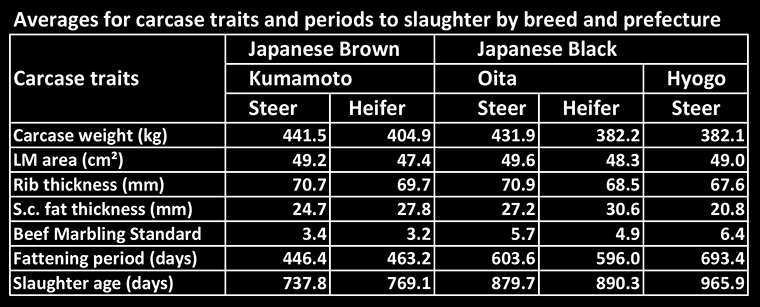
Japanese Black showed greater BMS than Japanese Brown, but with a longer fattening period and older slaughter age (P < 0.001). The Japanese Black steers in Hyogo were characterised by thinner subcutaneous fat thickness and smaller carcase weight than those in Oita (P < 0.001). The growth performance of the steers in Oita was superior to Hyogo. Unlike Japanese Black, Japanese Brown cattle are well known for growth performance. Their carcase weight was heavier but with a shorter fattening period than the Japanese Black cattle (P < 0.001).
Japanese Shorthorn (日本短角和種 Nihon Tankaku Washu) is raised in the north of the Tōhoku Region. The roots of Japanese Shorthorn are mainly from 'Nanbu' cattle in northern Japan during the Edo period (1603-1868) after the migration in 1454 to 1456 from Mongolia and Siberia. They were utilised as beasts of burden hauling seafood, salt and iron from the Pacific coast to the inland and rice, sake and supplies from the inland to the coast.
After American Shorthorn cattle were introduced to Iwaizumicho, Iwate Prefecture, in June 1871, they were crossbred with Nanbu cattle.
Subsequently, after mechanisation, the use of cattle steadily declined and Nanbu cattle were converted into beef cattle.
Japanese Shorthorn cattle are grazed in a system called natsuyama fuyusato. Literally meaning "summer mountain, winter village," this is a system whereby the cattle spend the summers grazing on plentiful grass in vast mountaintop pastures and the winters feeding in stalls as quasi members of the farm household.
In 1945 they were registered in Iwate Prefecture as Akage Tohoku-shu (Tohoku Brown), then renamed Nihon Tankaku-shu (Japanese Shorthorn) in 1952. The Japanese Shorthorn Cattle Registry Association was established in 1957 (Kazuto 2009, Minezawa 2003 and Namikawa 1999).
This breed is red-brown and deeper in coat colour than the Japanese Brown. The Japanese Shorthorn is superior to the traditional breeds in milking production, forage intake and growth rate. The Japanese Shorthorn share of the traditional herd has been reduced from the peak of 3% to 1%. The height is 128 and 140 cm and body weight 500 kg and 800 kg for females and males respectively.
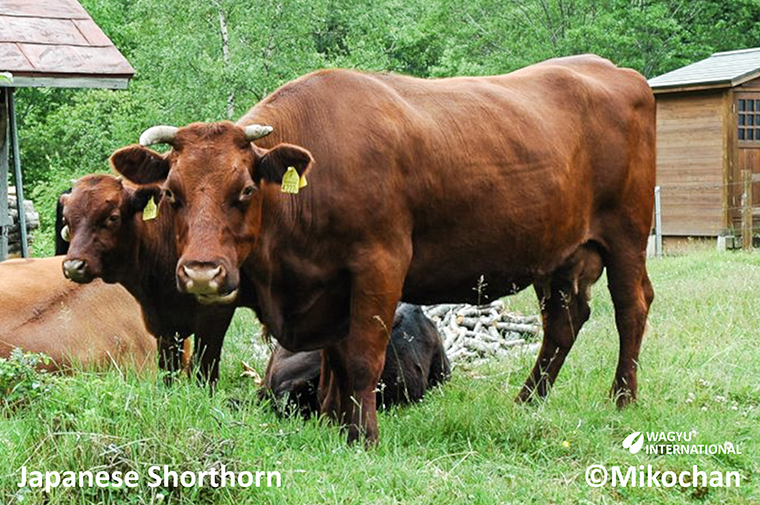 The national target set for 2010 for Japanese Shorthorn steers was a slaughter age of 19-20 months, livemass of 650-675 kilogram from an average daily gain of 1.10 kilogram per day. A BMS score of 3.0 was set.
The national target set for 2010 for Japanese Shorthorn steers was a slaughter age of 19-20 months, livemass of 650-675 kilogram from an average daily gain of 1.10 kilogram per day. A BMS score of 3.0 was set.
Japanese Poll (無角和種, Mukaku Washu) was produced through crossbreeding with Aberdeen Angus imported from Scotland. Subsequently Japanese Poll cows were crossed with Japanese Black in 1975 to improve meat quality but the numbers have dwindled. The height is 122 and 137 cm and body weight 450 kg and 800 kg for females and males respectively.
Mishima are native cattle introduced from Chugoku Prefecture on mainland Japan after the original cattle inhabitants on Mishima Island died from Rinderpest in 1672. The Mishima cattle retained the native breed characteristics that the original inhitants on the mainland had before crossbreeding was introduced for a few generations during the Meij Restoration. Cattle at that time were used for draught but needed size and milk so other breeds were imported but there was no crossing on Mishima Island. Mishima are mainly black with a small white spot on the udder or near the anus, or there can be some white hairs on black skin. It is more common for there to be some white than pure black. Ocassionally Mishima are dark brown. Horns are small, bluish-white, fine and round. The body is small but the chest is wide with the middle filled out then there is the narrow hind quarters and neck. Mishima steers average 517 (+/- 20) kg liveweight at the age of 35.8 (+/-0.5) months. The average wither height and body weight for females are 112.8 cm and 261.1 kg. The coat and skin are fine with curly hair. There is considerable variation in milk production but the maximum is 3.3 kg per day and lactation lasts 116 days. Bulls were used at three years of age and from five years they would serve 80 females. The meat quality is excellent. Their value is from crossing over Holstein which have the size while the marbling qualities is derived from the Mishima. Despite their common ancestry from Chogoka, Mishima cattle are registered as a Wagyu breed in Japan.
Kuchinoshima cattle are smaller and leaner than Mishima cattle but they are another native breed. The wither height of females is 110 cm and 120 cm for males. The coat colour is mainly black with a white spot in the belly. The legs may be brown and occasionally brown colour occurs overall. (Minezawa 2003).
Export to Europe
The European Union has opened the export of beef from Japan from certified plants. Japanese Livestock Industry Association specify true 'Wagyu' is either pure Japanese Black, Japanese Brown, Japanese Shorthorn or Japanese Polled. They must be born and reared in Japan using Japanese Wagyu production methods. They must be certified for three generations.
References
American Wagyu Association website.
Australian Wagyu Association website.
Kazuto, M. Japanese Shorthorn Cattle. Tokyo Foundation. 1st October 2009.
Ministry of Agriculture, Forestries and Fisheries.
Minezawa, M. 2003. Cattle genetic resources in Japan: One successful crossbreeding story and genetic diversity erosion. Cattle Genetic Resources in Japan. 4(2):71-87.
Nagamine, Y., Nirasawa, K., Takahashi, H., Sasaki, O., Ishii, K, Minezawa, M., Oda, S., Visscher, P.M. and Furukawa, T. 2008. Estimation of the time of divergence between Japanese Mishima Island cattle and other cattle populations using microsatellite DNA markers. J. Hered. 99(2):202-207.
Namikawa, K. 1992. Breeding history of Japanese Beef cattle and preservation of genetic resources as economic farm animals. Wagyu. 2nd ed. Wagyu Registry Assoc., Kyoto, Japan.
Obata, T., Takeda, H., Satoh, M. and Wada, Y. 1996. Progress in Breeding Technologies for Effective Beef Cattle Production in Japan. JARQ, 30: 203 - 211.
Sasaki, Y., Miyake, T., and T. Dougo. 2006. Comparison of genetic gains per year for carcass traits among breeding programs in the Japanese Brown and the Japanese Black cattle. J. Anim. Sci. 84:317-323.
Smith, S.B., Zembayashi, M., Lunt, D.K., Sanders, J.O. and C.D. Gilbert. 2001. Carcass traits and microsatellite distributions in offspring of sires from three geographical regions of Japan. J. An. Sci. 79:3041-3051.
DISCLAIMER Wagyu International provides information that has been supplied by other parties and gives no warranty (express or implied) as to the data completeness, accuracy or fitness for a particular purpose.
